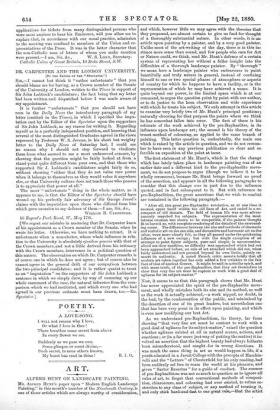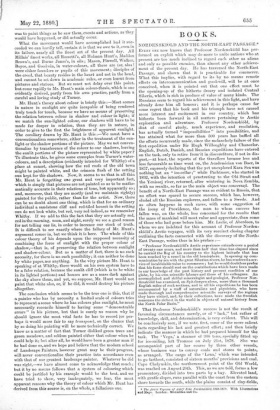ART.
ALFRED HINT ON LANDSCAPE PAINTING.
MR. ALFRED Hurr's paper upon" Modern English Landscape Painting," in this month's number of the Nineteenth Century, is one of those articles which are always worthy of consideration, and which, however little we may agree with the theories that they propound, are almost certain to give us food for thought
of a thoroughly substantial nature. In other words, it is an article, upon painting by a painter, and by a very good painter. Unlike most of the art-writing of the day, there is in this in- stance more sense than sound, and few people who care for Art or Nature could, we think, read Mr. Hunt's defence of a certain system of representing her without a fuller iasight into the difficulties of a thorough landscape painter. By "thorough we mean here a landscape painter who endeavours to paint beautifully and truly nature in general, instead of confining himself to one or two special phases of atmosphere or aspects of country for which he happens to have a facility, or in the representation of which he may have achieved a name. It is quite beyond our power, in the limited space which is at our- command, to argue the question point by point with our author,.
or to do justice to the keen observation and wide experience with which he treats his subject. We only attempt in this article.
to examine very briefly two of Mr. Hunt's principal positions ;- naturally choosing for that purpose the points where we think he has somewhat fallen into error. The first of these is his estimate of the work achieved by the pre-Raphaelites, in its influence upon landscape art; the second is his theory of the truest method of colouring, as applied to the same branch of painting. This latter question is, undoubtedly, the main one which is raised by the article in question, and we do not remem- ber to have seen in any previous publication so clear and so. forcible an exposition of the point at issue.
The first statement of Mr. Hunt's, which is that the change which has lately taken- place in landscape painting was of an earlier date and a different kind to the pre-Raphaelite move- ment, we do not propose to argue (though we believe it to be wholly erroneous), because Mr. Hunt brings forward no proof of the assertion, and appears in all the following paragraphs to.
consider that this change was in part due to the influence quoted, and in fact subsequent to it. But with reference to-
pre-Raphaelitism, the great assertions that we wish to combat are contained in the following paragraph
After all, this great pre-Raphaelite revolution, as at one time it seemed, spent itself within the old lines of Art, and ended in a re- conquest of old domain. The field of human life was more adven- turously searched for subjects. The representation of the most intense emotion was shown to be compatible, if the painter thought fit to have it so with complete rendering of the details of the surround- ing scene. The differences between the aim and methods of dramatic and realistic art on the one side, and decorative and harmonic art on the- other, were more clearly felt, as they all passed under the quickening influence of a new energy ; but with the single exception of an attempt to paint figure subjects, pure and simple, in unconvention- alised out-door sunshine, no difficulty was approached which had not been approached before, no rule of art attacked which did not, when. fairly understood and not pressed beyond its own limits, quietly re- assert its authority. A noted French critic asserts boldly that all modern art taken together has only added a few wrinkles to the fair face of that of ancient Greece. It might be said in a similar spirit, and with more truth, of the pre-Raphaelites, that they set themselves to show that very fine art must be content to work with a good deal of ' ugliness for its subject-matter."
Now, it seems to us that this paragraph shows that Mr. Hunt has never appreciated the spirit of the pre-Raphaelite move-
ment, and wholly mistakes both its aim and its method, as well as the work it actually achieved,—a work nipped, no doubt, in the bud, by the condemnation of the public, and minimised by the desertion of one of its great leaders, but nevertheless one- that has been very great in its effect upon painting, and which. is even now modifying our best Art.
As we understand pre-Raphaelitism, its theory, far from showing "that very fine art must be content to work with a good deal of ugliness for its subject-matter," raised the question whether ugliness existed at all in natural scenes, actions, and emotions; or (in a far more just way of putting the matter) it in- volved an assertion that the highest beauty had always hitherto been misunderstood, and sought .for in wrong directions. It was much the same thing in art as would happen in life, if a youth educated in a Jesuit College with the precepts of Macchia- velli and the " Letters " of Chesterfield for his only reading, had been suddenly set free to roam the world at his pleasure, and given " Sartor Resartus " for a guide of conduct. The essence of pre-Raphaelitism was not so much to question as to ignore all
rules of art, to forget that conventional methods of composi- tion, chiaroscuro, and colouring had ever existed, to refuse re-- strictiou to any class of subject, or any method of treating it, and only stick hard-a.nd-fast to one great rule,—that the artist
was to paint things as he saw them, events and actions, ae they would have happened, or did actually occur.
What the movement would: have accomplished had it sue- ,e,eecled we can hardly tell, certain it is that we owe to it, even in its failure, nearly all the finest art of the present day. All Millais' finest works, all Rossetti's, all Holman Hunt's, Maddox Brown's, and Burne Jones's, in oils ; Mason, Pinwell, Walker, Boyce, and Goodwin, in water-colours, all these are (or, alas ! were either founders or pupils of this movement; disciples of the creed, that beauty resides in the heart and not in the head, and cannot be set down in academic rules, or even learnt from pictures and statues. But we must not delay over this point, but come rapidly to Mr. Hunt's main colour-thesis, which is one -evidently derived, partly from his own practice, partly from a --careful and loving study of Turner.
Mr. Hunt's theory about colons- is briefly this :—Most scenes in nature in sunlight are quite incapable of being rendered truly touch for touch, because we have no means of preserving the relation between colour in shadow and colour in light; if we match the sun-lighted colour, our shadows will have to be made far deeper in relation, than they. are in nature, in order to give to the first the brightness of apparent sunlight. The corollary drawn by Mr. Hunt is this :—We must have a conventionalism somewhere, either in the treatment of the sun- light or the shadow portions of the picture. May we not conven- tionalise by transference of the colour to our shadows, leaving the sunlit portions of the picture represented by white paper ? To illustrate this, he gives some examples from Turner's water- -colours, and a description (evidently intended for Whitby) of a .place at sunset, showing how the red roofs of the old town might be painted white, and the crimson flush of the setting sun kept for tile shadows. Now, it seems to us that in all this, Mr. Hunt is forgetting one great and very important fact, -which is simply that pictures are not painted so as to be mathe- matically accurate in their relations of tone, but apparently so ; and, moreover, that they are mostly (and we maintain rightly) painted for the public, rather than for the artist. Now, there -can be no doubt about one thing, which is that for an ordinary individual a sandstone cliff and red-tiled househ in the setting sun do not look white, but red, very red indeed, as we remember Whitby. If we add to this the fact that they are actually red, red in the morning, noon, and night, surely we see a good reason for not telling one lie, in order to increase our stock of truth. it is difficult to see exactly where the fallacy of Mr. Hunt's argument comes in, but we think it is here. The whole of this colour theory of his depends upon the supposed necessity of combining the force of sunlight with the proper colour of shadow,--that is, of preserving the relation between sunlight and shadow-colour. But as a matter of fact, there is no such necessity, for there is no such possibility; it can neither be done IT white paper, nor anything. In the very picture Mr. Hunt is speaking of at Whitby, there would on his own system have to be a false relation, because the sunlit cliff (which is to be white in its lighted portions) and houses are as a mass dark against
the sky above them, and yet, we suppose, Mr. Hunt would not paint that white also, or, if he did, it would destroy his picture .altogether.
The conclusion which seems to be the true one is this, that if -a painter who has by necessity a limited scale of colours tries
to represent a scene where he has colours plus sunlight, he must necessarily reconcile himself to having some "demonstrable errors" in his picture, but that is surely no reason why he should ignore the most vital facts he has to record (or per-
haps it would more fair to say transpose), on the chance that by so doing his painting will be more technically correct. We
know as a matter of fact that Turner disliked green trees and green meadows, and seldom painted either that colour when he could help it; but after all, he would have been a greater man if be had done so, and we hope and believe that the modern school of Landscape Painters, however great may be their progress, will never conventionalise their practice into accordance even with that of our greatest landscape painter. Whatever he did was right,—we have almost come to acknowledge that much ; but it by no means follows that a ystem of colouring which could be justified by his example would be the best, and we
have tried to show, very inadequately, we fear, the most apparent reasons why the theory of colour which Mr. Hunt has derived from this source is, on the whole, a fallacious one.



































 Previous page
Previous page